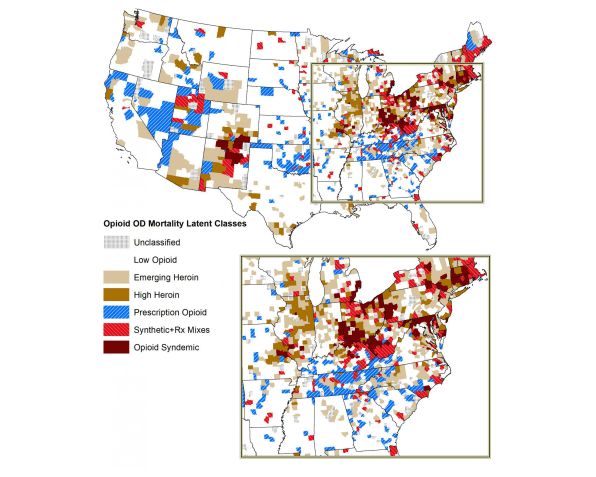This devastating opioid overdose map shows America is fighting 4 distinct epidemics
Excerpt:
Turns out that a single opioid crisis doesn’t actually exist. This year over 70,000 Americans have died in four distinct opioid epidemics, each bringing death through different drugs and regions.
 View larger image here. [Image: courtesy of David Peters]Researchers at Iowa State University studied death certificates nationwide and found these four separate drug outbreaks:
View larger image here. [Image: courtesy of David Peters]Researchers at Iowa State University studied death certificates nationwide and found these four separate drug outbreaks:
- The West and Midwest heroin epidemic: The overdose deaths cluster along interstates known to be smuggling routes for Mexican cartels. This epidemic is quite active in urban areas, and from El Paso to Denver, and in Texas through St. Louis into Chicago.
- The rural Southern prescription epidemic: This is a continuation of the nationwide pharmaceutical overdose crisis that peaked in 2013 but continues in rural counties. The opioids mostly come from pharmacies, often prescribed to work-disabled former miners or manufacturing workers for their pain. Now that pharmaceuticals are more difficult to access, traffickers are creating counterfeit pills with prescription drugs such as OxyContin and hydrocodone mixed with easy-to-overdose-on synthetic opioids such as fentanyl.
- The urban fentanyl epidemic: Street drugs such as heroin and cocaine are mixed with synthetic opioids and often made to look like prescription pills. This is ravaging Northeastern cities, as well as parts of Utah and New Mexico.
- The unemployment opioid epidemic: Some unlucky counties are undergoing a “syndemic,” which means multiple epidemics at once, where people consume whatever drugs (prescriptions, heroin, synthetics) they can get their hands on. This is happening in regions where the opioid epidemic first blossomed in the 1990s and which have since undergone heavy job losses from mining and manufacturing in states including Kentucky, Ohio, and West Virginia.
Replies
It brings to mind the WHO's approach to epidemics and how to stage the control and mitigation stage. Recently in California, there is a discussion on the negitive impact of to many warnings under prop. 65, and it begs the question, "When is informing the general public switch gears and just becomes white noise?" Should we be re-thinknig Opiods along the lines of incident managment or responder engagement in light of the growing foundation of data? I attached the WHO managing epidemics (diseases) just as referance.
https://www.who.int/emergencies/diseases/managing-epidemics-interac...
So ... the question that comes to mind is whether the appoaches the U.S. is taking -- locally, regionally and nationally -- take this sufficiently into account (if at all). Does an effective response require four distinct strategies or are there common denominators that can be address to make broad progress?